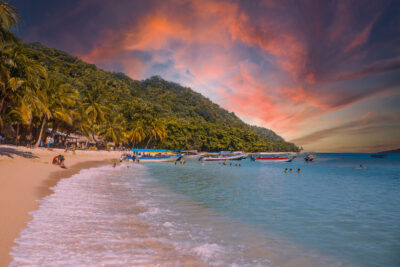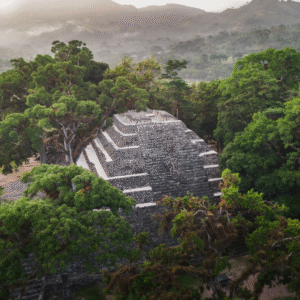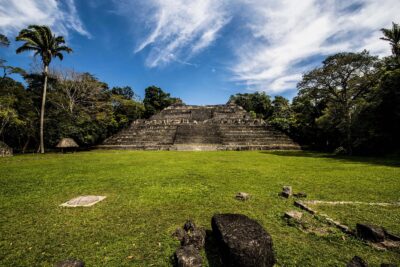
What to do on a multi-destination trip to Central America
From Guatemala to Panama, Central America is brimming with adventures in nature, archaeological sites, glistening islands and knowledgeable communities – here’s why you should visit more than one country while there
Marvel at pre-Hispanic archaeology
Mayan culture shaped much of Central America from as early as 2,000 BC, and today you’ll find a horde of well-preserved, ancient Mesoamerican sites here.
Among the most impressive is Guatemala’s Tikal, in the heart of the northerly Péten jungle. A powerful political hub until the 10th century, today its UNESCO-listed pyramids and temples peep out from an expanse of rainforest, with howler monkeys, jaguars and vibrant birds for company.
Just as intriguing are the Copán Ruins in western Honduras. Here intricately-carved stelae (stone monuments) and inscriptions throw a spotlight on the city’s advanced expertise in astronomy and maths – head to the extraordinary Hieroglyphic Stairway to see around 2,000 hieroglyphs carved in the walls.
El Salvador’s Joya de Cerén has meanwhile garnered a reputation as the ‘Pompeii of the Americas’; this pre-Hispanic farming village lay buried beneath volcanic ash after an eruption in AD 595, with many of its houses and treasures immaculately preserved.
Elsewhere, in Belize, you’ll find a further handful of intriguing sites – not least the inimitable Caracol, tucked into the dense Cayo jungle and home to the country’s tallest structure. Expect far-reaching rainforest and mountain views from the peak of this once all-powerful Mayan centre.
Discover the power of the Pacific
Central America is more than just its history, of course, and you’ll find some of the world’s best surfing on its sun-dappled Pacific coastline.
In Nicaragua, the laid-back town of San Juan del Sur has long drawn surfers and bohemian types with its gold-sand beaches, fuchsia-pink sunsets and lively nightlife, while smaller towns like Popoyo offer a chilled-out, secluded escape.
El Salvador has its own clutch of idyllic surf towns; expect colourful, mural-dotted streets and curvaceous black-sand beaches around El Tunco, its biggest town, and El Zonte, its quieter neighbour, with a handful of polished cafes, bars and restaurants drawing locals as well as visitors looking to take it slow.
Next door in Guatemala, the tiny coastal town of Sipacate offers a gateway to the mangrove forests and lagoons of Sipacate-Naranjo National Park, while Monterrico’s volcanic-sand beach draws locals after an escape from the bustle of Guatemala City.
Over in Panamá, the picturesque surf town of Playa Venao still feels like something of a secret, with turtles nesting on the beach – and if you’re here from July to October, you might just see humpback whales passing on their annual migration.
Immerse yourself in Caribbean rhythms
It’s not just the Pacific coast that lures in the region; for a taste of the Caribbean, head to Belize, where the castaway island of Caye Caulker lures with powder-white sand and palm-fringed, cerulean sea.
From here, hop on a two-hour boat to reach the legendary Great Blue Hole – an abyss of cobalt formed from a collapsed cave that’s renowned for its diving, with hammerhead sharks, groupers, turtles and rays inhabiting its crystal-clear waters.
As close to paradise as it comes, the Honduran islands of Roatán and Utila offer their own share of curacao-blue shores and floury sands, with a number of eco-conscious dive expeditions available. Elsewhere, Nicaragua’s Corn Islands mix brochure-perfect beaches with Creole culture and cuisine, offering an alternative side to this diverse country.
Beyond the Central American mainland, the Dominican Republic combines snow-white beaches with lush rainforest and waterfalls; for some of the best, head to the Samaná Peninsula – a natural haven whose forests were once a hideout for pirates, with coconut palms, mountains, rivers and caves forming a striking backdrop.
Learn about the culture of local communities
Outside of the Caribbean coast, there’s a whole swathe of other cultures to explore, with Indigenous groups still populating much of the region.
To learn more about Mayan culture today, head to Guatemala’s picturesque Lake Atitlán; here villages like San Pedro, San Juan La Laguna and San Marcos offer a snapshot into Mayan spirituality, with a laid-back, tranquil vibe and string of colourful artisanal markets.
In Honduras, the Lenca community make up the largest Indigenous group, and you can learn more about their culture on La Ruta Lenca, a grassroots tourism initiative. Visit La Campa to witness the village’s long-standing Lenca pottery heritage, and stay on to catch a Guancasco ceremony, when folk dances fill the streets.
Panamá’s self-governing Guna community meanwhile inhabit the San Blas islands; visit to experience their well-preserved traditions, including a unique language and mola textile heritage (think intricate, colourfully patterned clothing).
In the Dominican Republic, the spiritual rituals and musical traditions of syncretism – a blend of Catholic and African religious practices – can be seen at the country’s many patron saint festivals; swing by capital Santo Domingo for some of the liveliest celebrations.
Explore the boundless nature and adventure opportunities
Beyond the cultural traditions and coastal charms, Central America’s soaring volcanoes, cloud forests and cave systems make the region a hotspot for adventure.
At the heart of this scene is Nicaragua, where the Mombacho and Masaya volcanoes offer scenic jungle hikes with sweeping crater views. Away from the mainland, Ometepe Island on Lake Nicaragua lays claim to its own duo of volcanoes, alongside nature reserves, cocoa farms and waterfall trails; expect kayaking, cycling and birdwatching between the distinctive roar of howler monkeys.
In Panamá, Barú Volcano National Park is another hotspot for hiking and wildlife-watching – look out for resplendent quetzals and black-bellied hummingbirds, alongside capuchin monkeys, sloths and wild cats.
In El Salvador, El Imposible – the country’s largest national park – is home to emerald forested slopes, while Los Volcanes National Park lays claim to 14 volcanic peaks. Climb Santa Ana to peer into its luminescent-jade crater lake, steaming away amid the marbled rock.
For an alternative adventure, head to Actun Tunichil Muknal (or the ATM Cave) in Belize. This network of underground chambers was once considered a Mayan portal to the underworld; tours can take you gliding through its mystical caverns as you learn more about their spiritual significance.
Treat yourself to ancestral recipes and gastronomy
The best way to get to know a place is often its cuisine, of course, and Central America isn’t short on unique dishes to try.
Guatemala’s national dish is pepián – a lightly-spiced, curry-like chicken dish made with tomato and born from a fusion of Mayan and Spanish cultures. Kak’ik is another staple stew, made with chilli peppers, tomatoes, garlic, spices and turkey.
Nicaraguan specialities meanwhile include nacatamal – hearty, meat-filled tamales rooted in Indigenous Nicarao tribes – and indio viejo, a rich beef stew made from maize, sweet peppers and tender shredded meat.
For a different flavour, head to Honduras to try its Garifuna cuisine; standout dishes include machuca, a blend of coconut, fish and mashed plantain.
Or venture to the Dominican Republic; gastronomy here blends Taino, African and European influences, while the country’s swathes of organic cocoa farms produce some of the world’s best chocolate.
Across the entire region, the food here is a living memento of the many different cultures that have shaped its heritage, from the Mesoamericans to the present day – and a literal taste of what makes Central America so genuinely, mesmerisingly captivating.






































